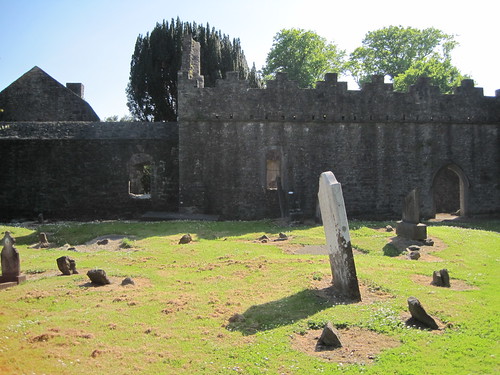5/22/10
I’ll be honest – Malahide Castle was disappointing.
After getting off the DART, I saw a really cool spire on top of what I soon found was a church, and not the castle. I should have known better than to think the train would have just dumped us off right in front a castle. None of us knew where we were going, so imagine a group of around 30 students walking up and down a narrow sidewalk outside the train station. I felt like an idiot wandering around, so I asked a guy if he knew how to get to the castle. He did, and we went back the original way we were headed.
I didn’t remember reading about this castle in the book, so I was just along for the ride today to see what adventure would come about. We walked for what seemed like forever into a giant forest, past fields of people playing football (soccer) and cricket, and a playground with a gargantuan slide at the center that I really wanted to slide down.
When we finally arrived at the castle after snaking through about 20 minutes of paths inside this large park, my first thought was, “That’s it?” When I think of castles, I think of grandiose buildings that are stories tall and surrounded by a moat. This building was maybe two large or three regular stories tall and covered in front by scaffolding and construction gates. Perhaps if I’d done more research prior to going, I would have known what I was getting into and not been so let down by the façade.
I thought, “Okay, so it isn’t that big, but maybe it has some sweet history behind it, and this lady is going to tell us everything we need to know.” She introduced the castle using a memorized script, before saying we would be guided by narrated tracks on speakers I’m sure the owners had during their stay.
I must’ve zoned out during the first few minutes because I didn’t hear anything I thought was that interesting. The castle was owned by the Catholic Talbot family and, from what I can gather, is probably most famous for its intricate carvings along walls and ceiling, as well as on various pieces of furniture. It was very crafty of the architect to only build windows in one side of the wall for defensive purposes, and the walls were up to eight feet thick in some places.
The rooms, brought to us by pre-recorded narrators, were drawing rooms where guests visited. I’m not sure why they called them drawing rooms, since I saw no easels, but it may be because they drew guests to these rooms when they hosted gatherings.
After three of these rooms, the lady from before directed us upstairs. As we walked around the top looking at bedrooms and various furnishings, as well as other artifacts, I kept trying to solve two questions almost that didn’t really have to do with what I was looking at. One – how does a family become rich enough to own a castle? And two – how come the audio narration ran out after only three tracks?
I couldn’t solve my first question.
But with regard to the narration, my answer may have been met by a tidbit the lady told us when going upstairs. While pointing to a portrait of two young Talbots with an adult – presumably a parent – she mentioned the little girl in the picture was the last member of the family to ever live in the castle.
According to our lector, the little girl, whose name was Rose, wound up living until 2009 in New Zealand, but had to sell the castle in the 1970s because the taxes were too high. Assuming the Talbots did, in fact, live with speakers in their house, perhaps the taxes were too much for Rose to pay and she had to stop the narration project for the upstairs rooms.
Of course, it’s a ludicrous idea. But it’s the only halfway feasible answer I can come up with.
I wonder if the Talbots enjoyed their tourist restaurant that was at the bottom of the stairs, too.

